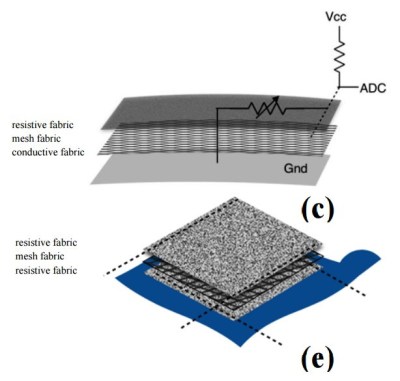Two researchers of Responsive Environments, MIT Media Lab, have put to together a device that is an amazing array of musical instruments squeezed into one flexible package. Made using seven layers of fabrics with different electrical properties, the result can be played using touch, proximity, pressure, stretch, or with combinations of them. Using a fabric-based keyboard, ribbon-controller, and trackpad, it can be played as a one-octave keyboard, a theremin, and in ways that have no words, such as stretching while pressing keys. It can also be folded up and stuffed into a case along with your laptop, and care has even been taken to make it washable.

Layer one, the top layer, is a conductive fabric for detecting proximity and touch. The twelve keys can work independently with a MPR121 proximity touch controller or the controller can treat them all as one, extending the distance the hand can be and have it still work. Layer two is just a knit fabric but layers three to six detect pressure, consisting to two conductive layers with a mesh fabric and a piezo-resistive fabric in between. The piezo-resistive fabric is LTT-SPLA from eeonyx, a knit fabric coated with the conductive polymer, polypyrrole (PPy). Layer seven consists of two strips of knitted spandex fabric, also coated with PPy, and detects stretching. Two strips of this are sewn on the bottom, one horizontal and one vertical. You can see and hear the amazing sound this all produces in the video below.

The long fabric ribbon-controller is a snap-on addition that allows sliding of a finger along its length. It consists of a resistive fabric on top of a non-conductive mesh which is on top of a conductive fabric. Pressing the resistive fabric causes it to make contact through the mesh with the conductive fabric underneath. Voltage is applied to one end of the resistive fabric and the finger position changes the resistance between that end and the conductive fabric. It’s the same trick often used with lines of graphite pencil marks on paper as in this example with a 555 timer circuit.
The trackpad is implemented as a resistive trackpad using a 4-wire configuration. We’ve already covered how a 4-wire configuration works in another article. In terms of the fabrics, two resistive fabrics were used for top and bottom with a non-conductive mesh layer sandwiched in between. Conductive threads were sewn into opposite ends of the resistive fabrics.
In addition to touch, a hand above the trackpad can toy with an electric field to alter sound parameters while the other hand presses the keys. A demonstration of this is in the video.
Two circuit boards were fabricated, one called FabricKeys and the other ThereminKeys. More about the group’s experimenting is in their paper, but they settled on a ribbon connector and an AdaFruit Feather M0 for the hub. They selected MIDI as the protocol for communicating with the computer.















It would be more suited for the hip-hop crowd as 4 notes, clack, and that one bass note is all you need. And of course a chorus generator to run the mic thru. Is there any soft-inst that could integrate all of these inputs? I would rather have the sensors in my shoes and other places, cause I would make two drummers out of it.
This is seriously amazing and with a little effort could completely reproduce the Roli Seaboard at a fraction of the cost.
MPR121 is a very nice controller, and good priced more or less $1.62
http://s.click.aliexpress.com/e/jYNf6eE
A lot of keys for a small micro!
This was really interesting to me. I’m not particularly musically-inclined, but a hat that screams as I crumple it would be fun!
Thanks for the “piezo-resistive fabric” information. Looks like it can take so serious abuse before degradation.
I like it! Clothing that talks back to you in some way.
I need some clothes like this!!